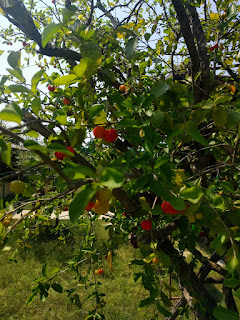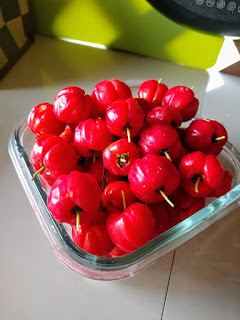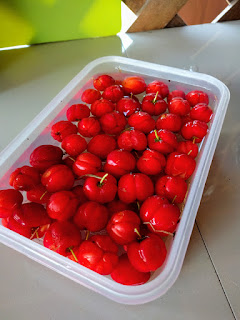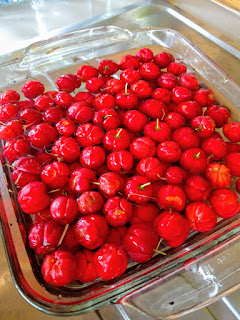Back in July of last year, I wrote about our new Thai cherry tree. The tree had come with a few cherries already on it, and I tried picking them and eating them, and while they were edible, they were sure sour.
The tree has come back into full fruit, and it is dropping more Thai cherries on the ground than I could possibly eat:
Having such an abundance of them, I’ve started to develop a bit of a taste for them. While they are a bit difficult to remove the seeds before you pop them in your mouth, they are actually quite easy to suck the fruit off of the seeds while they are in your mouth. (The seeds are roughly as soft as orange seeds, not break-your-teeth hard like cherry pits.)
They are still very sour, and I find that when I eat them, it must be before any other fruit otherwise the slightly sweet but very sour flavor of the Thai cherries is just reduced to pure sour. (Any other fruit will basically dull your sweet taste buds to the point where these are inedible.)
Nonetheless, they look so beautiful in the bowl:
And since I pick them up off the ground mostly, I wash and soak them for a few minutes, swishing the water around a bit to try to clean off the fruit:
Whenever I get a taste for any of the fruit on our land, I start looking around for nutritional information on the net. This time, it turned out a bit confusing.
Thai people literally call this fruit “cheree thai” (เชอรี่ไทย), so I did a search in Thai to see if anyone knew a more common English name. The two most “official” looking hits were here (Songkla university) and here (thaibiodiversity.org). Both of them refer to the English name as “Barbados cherry” and the Latin name as “malpighia glabra L.”.
The only problem is that Wikipedia seems to suggest that malpighia glabra is not Barbados cherry. Rather, it is a similar plant often times confused with Barbados cherry (which they say is actually malpighia emarginata). According to Wikipedia, malpighia emarginata is the actual Barbados cherry, while malpighia glabra has “small insipid fruit”.
Now my understanding of the word “insipid” in this context means bland and not very interesting. Presumably, this is in contrast to the very sour and highly cultivated Barbados cherry. The Thai cherry that we have is definitely sour, seems to be cultivated and I would be hard pressed to call the flavor “insipid”.
If you do a Google search for “Barbados cherry malpighia glabra”, you get lots of hits that say that Barbados cherry is malpighia glabra. Then if you do a Google search for “Barbados cherry malpighia emarginata”, you get lots of hits that say that Barbados cherry is malpighia emarginata.
So I’m not certain about who is right and who is wrong, but my best working hypothesis right now is that Thai cherry and Barbados cherry are the same fruit, and there is confusion as to what the correct Latin name is.
If this is true, then I am lucky indeed, as Barbados cherry (also known as acerola) has one of the highest contents of antioxidants of any fruit. The vitamin C content is about 32x more than oranges making it one of the top two or three highest concentrations of vitamin C of any known fruit. I’ve even read that vitamin C tablets used to be made from these before they began producing vitamin C synthetically. As such, it is considered a “superfood”. From what I’ve read, it isn’t available in supermarkets because the fruit doesn’t pack and travel well.
And based on how ridiculously sour these Thai cherries are, I think that the statement above about high vitamin C content is another piece of evidence that these fruit are the same as Barbados cherry/acerola.
Maybe we can try making Thai cherry pie next?






